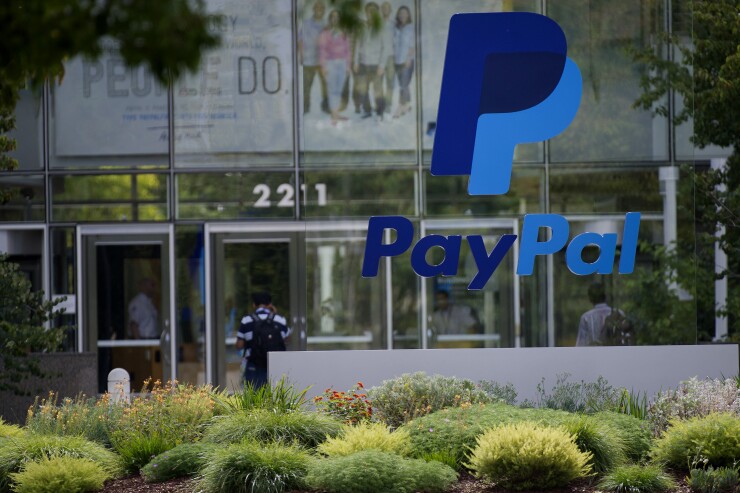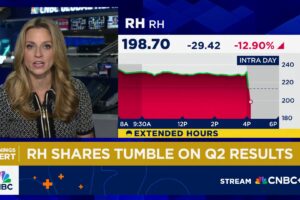
David Paul Morris/Bloomberg
PayPal’s attempts to recover from an earnings slump include more aggressive financial incentives to nab card payments market share from banks.
The payment company late this week announced PayPal Everywhere, a rewards marketing program that dangles up to 15% cash back, along with an easier connection to mobile payments. PayPal’s move comes as it tries to compete with card issuers that have expanded cash-back reward programs to reach inflation-wary consumers. PayPal also faces competition from other payment-focused technology companies such as Block that, like PayPal, are expanding financial services for both merchants and consumers.
“Merchants want to get in front of more customers, and consumers want more ways to save on everyday purchases,” said John Anderson, senior vice president and general manager of PayPal’s consumer group. “We’re designing our omnichannel experiences to benefit both.”
PayPal Everywhere gives consumers the ability to choose a monthly category, such as groceries or clothing, and get 5% cash back with a limit of $1,000 a month for payments using PayPal’s Mastercard debit. Consumers can also stack rewards. A 5% cash-back offer in the restaurant category can jump by an additional 10% if the consumer accesses a rewards deal from a PayPal app partner, such as DoorDash.
“PayPal is leaning in on a couple of its key assets, in particular its existing relationships with consumers and PayPal’s ability to see and leverage data from both sides of the transaction,” said Aaron Press, research director for worldwide payment strategies at IDC, noting PayPal has previously added technology that uses consumer-behavior data to improve marketing and product recommendations.
For banks to compete with a PayPal Everywhere-type offering, they need an all-in-one account that allows consumers to switch seamlessly between credit, debit, buy now/pay later, and prepaid within a digital wallet, said Richard Crone, a payments consultant. “Without this, they’re going to lose market share as consumers shift to lower-cost, fee-free options,” Crone said, adding consumers are migrating from credit to debit cards to access more cost-effective payments since debit cards usually have lower fees. “PayPal, Apple Pay and Google Wallet are already well ahead because they give consumers the flexibility to choose the most cost-effective payment method,” Crone said.
PayPal has an additional cost advantage with its PayPal Everywhere debit card by leveraging prepaid balances, which are drawn upon first before tapping into external funding sources like bank accounts, Crone said. “The marginal cost of using these prepaid balances is effectively zero for PayPal, as there are no external transaction costs involved,” Crone said.
In addition to sweetening incentives, PayPal is attempting to make it easier to access PayPal’s digital wallet and wallets from other technology companies. The PayPal Everywhere updates include an auto reload–consumers can choose to have their PayPal accounts topped up if their balance falls below a chosen threshold. PayPal has also made it easier to add Apple Wallet to the PayPal debit card and use the card with Apple Pay.
“PayPal is seeking to enhance adoption of cash balance and its debit card by adding enhanced rewards and merchant partnerships,” said Aaron McPherson, a payments consultant, who added that by partnering with Apple, PayPal “seems to be ceding ground to Apple Pay.”
During PayPal’s most recent earnings call, CEO Alex Chriss said the company is interested in opportunities stemming from greater access to the Near Field Communication technology that enables mobile payments. Chriss did not mention Apple, but he was indirectly referring to regulatory pressure that has led Apple to open access to the NFC technology on iPhones, creating an opportunity for other companies to offer payments to iPhone users.
Analysts from Jeffries have said Apple Pay’s pending desktop rollout, which will allow consumers to use Apple Pay on any third-party web browser through a code on their iPhone, could hinder PayPal’s growth. Chriss in the past has said PayPal has not seen an adverse effect from merchants or consumers based on browser usage.
PayPal did not answer questions about Apple for this article, and Apple did not return a request for comment by deadline. In the PayPal Everywhere release, Eddy Cue, senior vice president of services at Apple, said, “We’re excited to work with PayPal to bring Apple Pay to PayPal Debit Card cardholders and help deliver a seamless shopping experience to even more users.”
PayPal Everywhere follows the introduction of Fastlane earlier this year. Fastlane is a PayPal online checkout system that enables consumers to pay with a one-time passcode in a few taps. Fastlane draws on consumers’ past behaviors to recommend a payment option, acting as a payment facilitator that routes transactions to the best option for the payor. Fastlane and Everywhere are part of a trend at PayPal toward using consumer data to provide a rapid checkout experience that is usually reserved for returning customers, according to IDC’s Press.
“While there are some comparable multi-merchant stored credential programs, they are generally limited to a single platform or marketplace, whereas Fastlane is a more open offering,” Press said.



